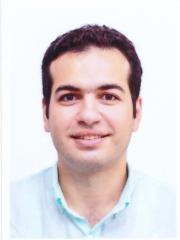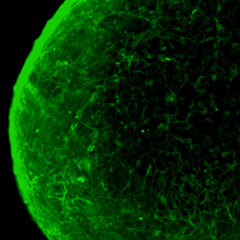
Organoid Biology
Dr Shaker demonstrated:
- Successful generation of white matter-like tissues in organoids, this tissue is enriched with myelinating oligodendrocytes, neurons and astrocytes (Shaker MR et al, Frontiers in Cellular Neuroscience 2021). This protocol is robust and rapid that involves a 42-day exposure of neuroectoderm-derived organoids to a cocktail of growth factors and small molecules that collectively foster oligodendrocyte specification and survival along with neurons and astrocytes. This platform prompted the discovery of NELL2 expression in human oligodendroglial cell types and NELL2 was further linked with human white matter development and diseases by using artificial intelligence prediction (Shaker MR et al, Frontiers in Cell and Developmental Biology, 2022).
- Human cortical organoids develop the typical hallmarks of senescent cells when maintained in vitro for prolonged periods of time, and moderate upregulation of endogenous KL expression in cortical organoids inhibits neuronal senescence (Shaker MR et al, NPJ Aging and Mechanisms of Disease 2021). This platform offers new mechanistic insight into its role in human brain ageing.
- Successful generation of the blood-cerebrospinal fluid barrier of the choroid plexus in human organoids (Shaker MR et al, BioRxiv 2020), this protocol is highly reproducible independent of cell lines, clones or batches.
Currently, Dr Shaker is working on two main projects:
- Modelling leukodystrophy using 4 reprogrammed patients' iPSCs lines with an oligodendrocyte brain organoid
- Modelling Down Syndrome using patient and isogenic human iPSCs lines with Choroid Plexus-Ventricle-Cortical organoid
A neuroscientist, Dr Shaker received his PhD in 2017 from Korea University, Seoul-South Korea, after working on the cellular behaviour of embryonic neural stem cells during the brain and spinal cord development as well as axial elongation. Dr Shaker obtained the Brain Korea 21 Plus Fellowship from the Korea Univesity Medical School before being appointed in AIBN-UQ to work in Professor Ernst Wolvetang's laboratory as a Postdoctoral Research Fellow in Organoid Biology to continue his research into the importance of modelling the human central nervous system in health and disease using organoid technology.
Key publications
Shaker, Mohammed R., Hunter, Zoe L. and Wolvetang, Ernst J. (2022). Robust and highly reproducible generation of cortical brain organoids for modelling brain neuronal senescence in vitro. Journal of Visualized Experiments, 2022 (183) e63714. doi: 10.3791/63714
Neural epidermal growth factor-like like protein 2 is expressed in human oligodendroglial cell types
Shaker, Mohammed R., Kahtan, Amna, Prasad, Renuka, Lee, Ju-Hyun, Pietrogrande, Giovanni, Leeson, Hannah C., Sun, Woong, Wolvetang, Ernst J. and Slonchak, Andrii (2022). Neural epidermal growth factor-like like protein 2 is expressed in human oligodendroglial cell types. Frontiers in Cell and Developmental Biology, 10 803061, 803061. doi: 10.3389/fcell.2022.803061
Shaker, Mohammed R., Lee, Ju-Hyun, Kim, Kyung Hyun, Ban, Saeli, Kim, Veronica Jihyun, Kim, Joo Yeon, Lee, Ji Yeoun and Sun, Woong (2021). Spatiotemporal contribution of neuromesodermal progenitor-derived neural cells in the elongation of developing mouse spinal cord. Life Sciences, 282 119393, 1-11. doi: 10.1016/j.lfs.2021.119393
Klotho inhibits neuronal senescence in human brain organoids
Shaker, Mohammed R., Aguado, Julio, Chaggar, Harman Kaur and Wolvetang, Ernst J. (2021). Klotho inhibits neuronal senescence in human brain organoids. npj Aging and Mechanisms of Disease, 7 (1) 18, 1-12. doi: 10.1038/s41514-021-00070-x
Rapid and efficient generation of myelinating human oligodendrocytes in organoids
Shaker, Mohammed R., Pietrogrande, Giovanni, Martin, Sally, Lee, Ju-Hyun, Woong, Sun and Wolvetang, Ernst J. (2021). Rapid and efficient generation of myelinating human oligodendrocytes in organoids. Frontiers in Cellular Neuroscience, 15 631548, 1-11. doi: 10.3389/fncel.2021.631548
| Featured projects | Duration |
|---|---|
| Personalising Epilepsy Regimes with Stem cells and artificial Intelligence models for Superior Treatment outcomes (PERSIST) | 2021–2024 |
| Understanding and treating childhood white matter disease | 2021–2024 |

